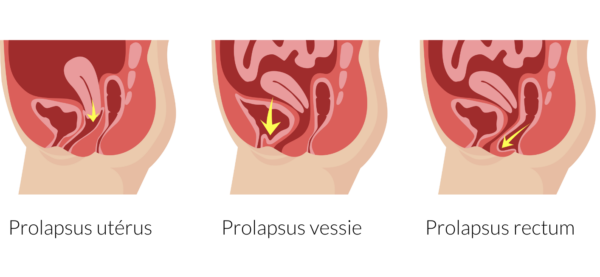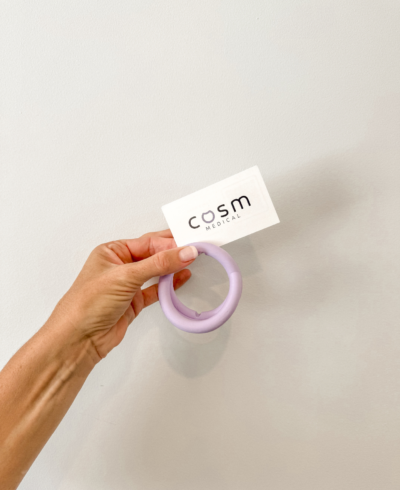Pessary: an intravaginal prosthesis that provides support!
Qu’est-ce qu’un pessaire? Le pessaire est un dispositif médical amovible en silicone s’utilisant comme une prothèse intravaginale. Ce dispositif que l’on insère dans la cavité vaginale est principalement utilisé pour soutenir les descentes d’organes et corriger l’incontinence urinaire, et l’incontinence urinaire à l’effort.
Il fonctionne en exerçant une pression sur la paroi vaginale et/ou l’urètre, ce qui aide à maintenir l’angle de l’urètre en position et empêche ainsi les fuites urinaires lors d’efforts physiques, comme la toux ou le rire. Il existe plusieurs tailles et types de pessaires (anneau, cube, Gellhorn, etc.), chacun adapté à différentes anatomies et degrés de prolapsus ou d’incontinence.
Le choix, la commande et l’ajustement du pessaire peuvent être faits par les professionnelles Cigonia qui prennent en compte les besoins spécifiques de chaque patiente pour trouver le modèle et la taille qui offrent un soutien optimal et un confort adéquat. Il s’utilise de manière temporaire ou bien pour de longues durées, selon ses raisons d’utilisation.
À noter qu’une prescription de votre médecin sera necessaire.


Beware of false beliefs!
One might think that pessaries are only indicated for mature women with complex pelvic issues, but it’s quite the opposite! Stress urinary incontinence or mild organ prolapse can be corrected with the additional support provided by this surprisingly comfortable device. It is now used by young female athletes, pregnant or breastfeeding women, and women who want to get back to being active. The pessary can be left in place for long periods, such as a few weeks, or used for short periods for specific needs. Its effectiveness is well documented for relieving vaginal heaviness and urinary incontinence.
Organ prolapse: be attentive to the symptoms indicating a prolapse
A prolapse occurs when internal organs descend or move out of their normal position through an opening in the body. Here are some common types of pelvic prolapse:
- Uterine prolapse: Descent of the uterus into the vagina.
- Vaginal vault prolapse: Descent of the vaginal vault into the vagina.
- Anterior wall prolapse (cystocele): Descent of the bladder into the vagina.
- Posterior wall prolapse (rectocele): Descent of the rectum into the vagina.
- Rectal prolapse: Protrusion of the rectum through the anus.

Prolapses can be caused by various factors, including childbirth, aging, obesity, and certain lifestyles. Symptoms vary depending on the type and severity of the prolapse and can include pain, urinary problems, or sensations of vaginal pressure. Treatment can range from physical therapy to surgery, depending on the severity and symptoms.
Be attentive to the symptoms! A prolapse can sometimes be insidious and develop gradually without being noticed. If you have a feeling of heaviness or vaginal presence, these symptoms are often the first perceived during an organ prolapse.
In the presence of a prolapse, the goal is to regain daily comfort and resume all activities without being limited by this problem, which is rarely dangerous but very inconvenient. Remember ladies, there is hope through strengthening and the use of pessaries.
Custom pessaries with COSM
Although there are many types of pessaries, the art of taking accurate measurements is reserved for skilled professionals. Since summer 2024, Cigonia has become the 2nd clinic in Québec to offer measurement services for COSM Medical pessaries, a Canadian company providing custom pessaries for women who are harder to fit. Sometimes, a few millimeters can make all the difference in keeping the pessary in the right position.
The experts at our clinic can help you find THE right pessary model tailored to your anatomy and needs.

Perineal physiotherapy is your best ally for resolving urinary incontinence and correcting prolapses
Perineal physiotherapy plays a crucial role in the treatment of urinary incontinence and prolapses. This therapy is usually attempted first and can be combined with the use of a pessary if necessary. Here’s how perineal physiotherapy can help you:
- Muscle strengthening: Physiotherapy teaches exercises to strengthen the pelvic floor muscles, which can improve the support of pelvic organs and reduce symptoms of incontinence and prolapse.
- Body awareness: Physiotherapists help patients become aware of their body and pelvic muscles, promoting better muscle activation and increased control.
- Relaxation techniques: Certain relaxation and breathing techniques can help reduce tension in the pelvic muscles, which can be beneficial for people with functional disorders.
- Improved circulation: Physiotherapy can promote blood circulation in the pelvic region, aiding in healing and tissue regeneration.
- Education: Physiotherapists provide information on posture, lifestyle habits, and proper techniques during physical activity, which can prevent symptoms.
- Manual techniques: Certain techniques, such as massage or tissue mobilization, can be used to improve function and reduce pain.
- Personalized approaches: Each patient is unique and physiotherapy allows for the adaptation of exercises and techniques to meet individual needs.